Gould's petrel
| Gould's petrel | |
|---|---|
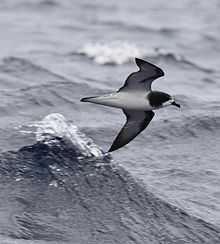 | |
| Conservation status | |
| Scientific classification | |
| Kingdom: | Animalia |
| Phylum: | Chordata |
| Class: | Aves |
| Order: | Procellariiformes |
| Family: | Procellariidae |
| Genus: | Pterodroma |
| Species: | P. leucoptera |
| Binomial name | |
| Pterodroma leucoptera (Gould, 1844) | |
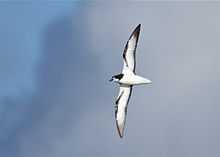
Gould's petrel (Pterodroma leucoptera) is a species of seabird in the Procellariidae family. The common name commemorates the English ornithologist and bird artist John Gould (1804-1881).[2]
Description
Gould's Petrel is a small petrel, white below and dark brown and grey above.[3] There is a dark M pattern across the upper wings, as in all members of the genus Pterodroma.[4] Gould's Petrel has long narrow wings, a short rounded tail and the head is noticeably dark, with a white forehead and face. Gould's Petrel is 30 cm in length with a wingspan of 70 cm and weighs 180-200g. Males are slightly larger than females.[5]
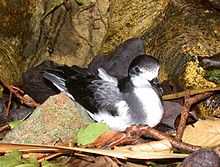
Taxonomy
There are two races of Gould's Petrel. The nominate race (Pterodroma leucoptera leucoptera) breeds on several small islands off the New South Wales coast in Australia. The other race (P. l. caledonica) sometimes known as the New Caledonian Petrel, is slightly larger than the nominate race and has whiter outer tail feathers. It breeds in New Caledonia.[6]
Some authorities regard the Collared Petrel (P. brevipes) as another subspecies of Gould's Petrel and some raise the New Caledonian Petrel to species status and regard the three taxons as a superspecies.[7]
Name
Gould's Petrel is sometimes known as the White-winged Petrel, but this name suits other species better than this one, so the name Gould's Petrel is preferred.[8] Gould's Petrel is the name chosen by W.B. Alexander in his classic work Birds of the Ocean. [9]
Gould described this bird in 1844, calling it Cook's Petrel Procellaria cookii after James Cook.[10] In his 1865 Handbook he changed the name to White-winged Petrel Aestrelata leucoptera. [11]
Today it is known as Gould's Petrel Pterodroma leucoptera.

Distribution
Gould's Petrels spend most of their life at sea and come ashore only to breed.[12]
Prior to the 1990s it was thought that the Australian race of Gould's Petrel bred only on Cabbage Tree Island off Port Stephens in New South Wales. Since then a smaller colony has been established on nearby Boondelbah Island.[13] In December 2009, just one month after it had been confirmed that rabbits had been eliminated from the island, one single Gould's Petrel was found incubating an egg on another nearby island, Broughton Island.[14]
Today, the nominate race breeds on four islands off New South Wales (Cabbage Tree Island, Boondelbah Island, Broughton Island and Little Broughton Island). The New Caledonia race breeds mainly on New Caledonia on steep forested valleys on the central mountain chain, from 450–500 metres above sea level between Mountains Dzumac and Poya. There is also a small colony on Raivavae in French Polynesia.[15]
Both races forage in the Tasman Sea while breeding and may venture as far west as the Indian Ocean before laying. After breeding, Gould's Petrel forages in the eastern tropical Pacific Ocean, each subspecies occupying distinct areas, the nominate race being generally further to the west.[16]
Gould's Petrels (of unknown subspecies) were sighted in December 1994 in waters south of Western Australia. It is deduced that these were not breeding birds, because in December breeding birds are incubating (see Life History below), and these waters are too far from the breeding colonies for a foraging trip.[17]
Diet
Little is known about the diet or feeding behaviour of Gould's Petrels. We do know that they eat small cephalopods and fish, and that variation in foraging success is substantial.[18]
Procellariiforms go without food during often lengthy incubation shifts.[19]
Life History
Pterodromas have relatively long breeding seasons. They are generally monogamous and form long-term pair bonds.[20]
Interestingly, while most petrels nest in burrows, as do the Gould's Petrels on New Caledonia, the Australian race of Gould's Petrel does not. On Cabbage Tree Island, they nest in rock crevices, in hollow trunks of fallen palms and buttresses of fig trees.[21]
On Cabbage Tree Island, birds arrive in mid-October to secure their nest site and reunite with their mate. In November they return to sea for 2–3 weeks. The single egg (which is not replaced if lost) is laid between 18 November and 10 December. Incubation is undertaken by both parents and takes 6–7 weeks. Males undertake the first shift which can be as long as 17 days. Females then take over for a shorter shift. Finally, males take the final shift until the egg hatches some time in January. The chick is often more than 130% of the body mass of either of its parents. The young fledge in late May at 80–100 days of age and a body mass of 160-180 g.[22]
The age at which Gould's Petrels commence breeding is unknown. The youngest bird of the Australian race known to breed was 12 years of age.[23] Young birds are thought to spend the first 5–6 years at sea before starting to breed. However, during this time they do return to their natal breeding colony to establish pair-bonds and to learn courtship and breeding skills.[24]
The longevity of Gould's Petrel is unknown. The oldest known member of the Australian race is over 23 years old.[25]
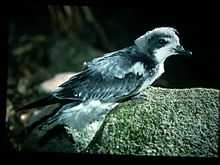
Population Decline
In the early 1990s the breeding population of Australian Gould's Petrels was fewer than 250 pairs. Breeding success was less than 20% and fewer than 50 young fledged each year. Each year more adults died than chicks fledged successfully.[26] In 1992 scientists estimated that the population had declined by 26% over the previous 22 years.[27]
Research revealed that the major problems were (a) sticky fruit of the birdlime tree (Pisonia umbellifera) which immobilised birds; (b) predation by Pied Currawongs (Strepera graculina) [28] and (c) habitat degradation caused by grazing of European Rabbits (Oryctolagus cuniculus). Rabbits had eaten the undergrowth allowing sticky birdlime fruit to fall to the ground, so birds, both adults and chicks, were exposed to fruit which would otherwise have been entangled in shrubbery.[29]
Management on Cabbage Tree Island
Population decline was unsustainable and intervention was required. In 1993 birdlime trees in the nesting colony were removed and Pied Currawongs were culled. Rabbits were eradicated from the island in 1997. Fledging success increased from fewer than 50 to more than 450 per annum and the number of breeding adults increased to over 1,000 pairs.[30]
Removal of emergent pisonia seedlings and culling of Pied Currawongs may need to continue for several years. Annual surveys estimate the size of the breeding population, breeding success and the number of fledglings produced. Because birds were monitored closely there was concern that ornithologists' intrusion could upset the birds and affect breeding success. However, this does not appear to be the case. In one study conducted in 2000/01, the breeding success of birds handled regularly during incubation was higher than for the colony as a whole.[31]
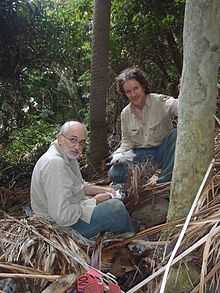
Having just one population was deemed an unacceptable risk, so nest boxes were developed and chicks were translocated to nearby Boondelbah Island. Most seabirds are strongly philopatric, so translocating chicks is difficult. Young must be moved before fledging. They are taken away from parental care and fed artificially. Gould's Petrels breed less synchronously than many other seabirds: each stage of egg-laying, hatching and fledging takes place over a period of 6–7 weeks. Scientists had to determine the optimum time to translocate chicks, so their natal nest was not 'imprinted' on them and yet they had the maximum chance of survival without parental care.[32]
Conservation Status
Management measures for the Australian race of Gould's Petrel have been so successful that the subspecies' conservation status has been down-graded from endangered to vulnerable. In 2010, the total population of the Australian race of Gould's Petrels was estimated to be 2,500 individuals and increasing.[33]
At the same time, the population of the New Caledonian race was estimated at 10,000 individuals and decreasing. However, this number is no more than an estimate and scientitsts do not have high confidence that it is correct.[34]
The New Caledonian race is also classified as vulnerable because of its restricted geographic breeding range.[35]
Threats
The main threats to the nominate race are the introduction of feral predators (cats Felis catus or black rats Rattus rattus or foxes Vulpes vulpes or dogs Canus familiaris) or wild fire, particularly in December when birds are incubating. Because of their chosen precarious nesting habits, accidental egg breakage is not unusual.[36]
The major threat to the New Caledonian race is introduced predators at the nest. Introduced pigs (Sus scrofa) dig up burrows. Black rats prey on birds and eggs. In addition, adults are killed at night when they fly into lights on Nouméa.[37]
References
- ↑ BirdLife International (2012). "Pterodroma leucoptera". IUCN Red List of Threatened Species. Version 2013.2. International Union for Conservation of Nature. Retrieved 26 November 2013.
- ↑ Beolens, Bo; Watkins, Michael (2003). Whose Bird? Men and Women Commemorated in the Common Names of Birds. London: Christopher Helm. pp. 145–146.
- ↑ Marchant, S. and Higgins, P.J. (1990) Handbook of Australian, New Zealand and Antarctic Birds Vol I Part A
- ↑ Onley, Derek and Scofield, Paul (2007) Albatrosses, Petrels and Shearwaters of the World. London: Christopher Helm.
- ↑ O'Dwyer, T.W., Buttemer, W.A. and Priddel, D.M. (2007) Differential rates of offspring provisioning in Gould's petrels: are better feeders better breeders? - Australian Journal of Zoology. 55: 155-160.
- ↑ Imber, J.J. and Jenkins, J.A.F. (1981) The New Caledonian Petrel. - Notornis 28: 149-160
- ↑ Marchant, S. and Higgins, P.J. (1990) Handbook of Australian, New Zealand and Antarctic Birds Vol I Part A
- ↑ Hindwood, K.A. and Serventy, D.L. (1941) The Gould Petrel of Cabbage Tree Island. - The Emu. XLI: 1-20.
- ↑ Alexander, W.B. (1928) Birds of the Ocean. New York. p. 48
- ↑ Gould, John (1844) Ann. Mag. Nat. Hist. vol XIII May 1, p. 364
- ↑ Gould, John (1865) Handbook to the Birds of Australia. Vol 2, p. 454.
- ↑ Priddel, D. and Carlile, N. (1997) Conservation of the endangered Gould's Petrel Pterodroma leucoptera leucoptera. Pacific Conservation Biology Vol 3: 322-29.
- ↑ Priddel, D. and Carlile, N. (1997) Boondelbah Island confirmed as a second breeding locality for Gould's Petrel Pterodroma leucoptera leucoptera. Emu 97: 245-248.
- ↑ Priddel, D. et al (2011) Pages 337-344 in Veitch, C.R., Clout, M.N. and Towns, D.R. (eds) Island invasives: eradication and management. IUCN. Gland, Switzerland.
- ↑ Garnett, S.T., Szabo, J.K. and Dutson, G. (2011) The Action Plan for Australian Birds 2010 Collingwood. CSIRO Publishing.
- ↑ Priddel, David et al (2014) Pelagic distribution of Gould's Petrel (Pterodroma leucoptera): linking shipboard and onshore observations with remote-tracking data. - Emu 114: 360-370.
- ↑ Surman, C.A., Cheshire, N.G. and Wooller, R.D. (1997). Gould's Petrel Pterodroma leucoptera off south-western Western Australia. Marine Ornithology 25: 70-71.
- ↑ O'Dwyer, T.W., Buttemer, W.A. and Priddel, D.M. (2007) Differential rates of offspring provisioning in Gould's petrels: are better feeders better breeders? Australian Journal of Zoology 55: 155-160.
- ↑ O'Dwyer, T.W. Buttmmer, W.A. and Priddel, D.M. (2007) Differential rates of offspring provisioning in Gould's petrels: are better feeders better breeders? - Australian Journal of Zoology 55: 155-160
- ↑ O'Dwyer, T.W. Buttmmer, W.A. and Priddel, D.M. (2007) Differential rates of offspring provisioning in Gould's petrels: are better feeders better breeders? - Australian Journal of Zoology 55: 155-160
- ↑ Hindwood, K.A. and Serventy, D.L. (1941) The Gould Petrel of Cabbage Tree Island. - The Emu XLI: 1-20
- ↑ O'Dwyer, T.W. Buttmmer, W.A. and Priddel, D.M. (2007) Differential rates of offspring provisioning in Gould's petrels: are better feeders better breeders? - Australian Journal of Zoology 55: 155-160
- ↑ Pridell, D. et al (1995) The status of Gould's Petrel Pterodroma leucoptera leucoptera on Cabbage Tree Island, New South Wales. Wildl. Res. 22, 601-10.
- ↑ Priddel, D. and Carlile, N. (2001) A trial translocation of Gould's Petrel (Pterodroma leucoptera leucoptera) Emu 101: 79-88.
- ↑ Priddel, D et al (1995) The status of Gould's Petrel Pterodroma leucoptera leucoptera on Cabbage Tree Island, New South Wales. - Wildl. Res. 22, 601-10
- ↑ Priddel, D. and Carlile, N. (2009) Key elements in achieving a successful recovery programme: A discussion illustrated by the Gould's Petrel case study. Ecological Management and Restoration Vol 10 No S1 May 2009
- ↑ Priddel, D. and Carlile, N (2007) Population Size and Breeding Success of Gould's Petrel Pterodroma leucoptera leucoptera on Cabbage Tree Island, New South Wales 1996-97 to 2005-06. Corella 31 (3/4): 79-82.
- ↑ Priddell, D. and Carlile, N. (1995) Mortality of Adult Gould's Petrels Pterodroma leucoptera leucoptera at the Nesting Site on Cabbage Tree Island, New South Wales. Emu Vol 95, 259-264.
- ↑ Priddel, D and Carlile, N. (2009) Key elements in achieving a successful recovery programme: A discussion illustrated by the Gould's Petrel case study. - Ecological Management and Restoration Vol 10 No S1 May 2009
- ↑ Priddel, D and Carlile, N. (2009) Key elements in achieving a successful recovery programme: A discussion illustrated by the Gould's Petrel case study. - Ecological Management and Restoration Vol 10 No S1 May 2009
- ↑ O'Dwyer, T.W., Buttemer, W.A. and Priddel, D.M. (2006) Investigator disturbance does not influence chick growth or survivorship in the threatened Gould's Petrel Pterodroma leucoptera Ibis. 148: 368-372.
- ↑ Priddel, D. and Carlile, N. (2001) A trial translocation of Gould's Petrel (Pterodroma leucoptera leucoptera). - Emu 101: 79-88.
- ↑ Garnett, S.T., Szabo, J.K. and Dutson, G. (2011). The Action Plan for Australian Birds 2010. Collingwood. CSIRO Publishing
- ↑ Garnett, S.T., Szabo, J.K. and Dutson, G. (2011). The Action Plan for Australian Birds 2010. Collingwood. CSIRO Publishing
- ↑ Garnett, S.T., Szabo, J.K. and Dutson, G. (2011). The Action Plan for Australian Birds 2010. Collingwood. CSIRO Publishing
- ↑ O'Dwyer, T.W., Buttemer, W.A. and Priddel, D.M. (2007) Differential rates of offspring provisioning in Gould's petrels: are better feeders better breeders? - Australian Journal of Zoology 55: 155-160
- ↑ Garnett, S.T., Szabo, J.K. and Dutson, G. (2011). The Action Plan for Australian Birds 2010. Collingwood. CSIRO Publishing
- BirdLife International (2011) Species factsheet: Pterodroma leucoptera. Accessed on 31 October 2011.
